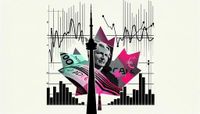Canada’s economy faces significant challenges as it grapples with rising inflation, job losses, and uncertainty in the wake of U.S. President Donald Trump’s recent tariff announcements. March 2025 saw a dramatic decline in the Canadian labor market, with 33,000 jobs cut, marking the largest monthly job loss since December 2022, according to Statistics Canada. This downturn has raised alarms about a potential recession in Canada for the second and third quarters of 2025, as noted by Douglas Porter, chief economist at BMO.
Porter attributes the labor disruption to a combination of factors, primarily the uncertainty surrounding Trump’s tariffs on Canadian industries, including automobiles, steel, and aluminum. He stated, “The bigger issue is the reality we're dealing with on the trade front. I think that alone was going to crimp Canadian growth in any event, because of the uncertainty it caused for businesses and for consumers.” This economic uncertainty has resulted in an increase in the unemployment rate from 6.6% to 6.7% in March, with projections indicating it will continue to rise over the next six months.
As global equity markets tumble to their lowest levels since the onset of the COVID pandemic, Porter warns that the downdraft will further weigh on Canadian sentiment, increasing the risk of a two-quarter contraction. “I thought it was quite telling that decline in March. It does show that employers turned a lot more cautious in the late winter, probably because of the trade uncertainty,” he remarked.
In the face of these challenges, the Bank of Canada is contemplating interest rate cuts to bolster the fragile economy. Recent surveys indicate that inflation expectations have reached a near three-year peak, while job insecurity looms over Canadians, with over 20% fearing job loss within the year. At the same time, expectations for wage growth have hit their lowest in more than two years, signaling a labor market struggling under the weight of trade-driven inflation.
According to Rosenberg Research, the futures market anticipates that the Bank of Canada may implement three additional rate cuts by the end of 2025. The bleak business sentiment has persisted for nine consecutive quarters, with hiring forecasts reflecting the lowest levels since late 2015. This environment suggests a precarious economic landscape where consumer spending could decline further, raising deflationary risks.
In a recent Business Outlook Survey by the Bank of Canada, 32% of firms expressed expectations that Canada will enter a recession within the next year, a significant increase from 15% in previous quarters. The survey highlighted that uncertainty surrounding financial, economic, and political conditions remains a top concern for firms. Only 43% of businesses anticipated sales growth in the coming year, down from 53% in the fourth quarter of 2024.
Investment expectations have also dwindled, with only 31% of businesses planning to increase spending on machinery and equipment, compared to 48% in the previous quarter. As a result, many firms are delaying important decisions related to investment and hiring until they have a clearer outlook. The report also indicated that two-thirds of businesses believe their costs would rise if widespread tariffs are implemented, leading many to increase their selling prices.
Adding to the economic woes, global financial markets have been in turmoil since Trump’s announcement of a sweeping tariff regime, which has sparked speculation of a prolonged economic downturn. The meltdown could trigger the most severe global economic crisis since the COVID-19 pandemic, prompting speculation that the Federal Reserve may consider an emergency interest rate cut in response to growing recession fears.
Despite the turmoil, the Bank of Canada appears reluctant to slash rates to rock-bottom lows as it did during the pandemic in March 2020. CoStar Group chief economist Carl Gomez noted that the central bank is cautious of inflation risks, having been “badly burned” when inflation soared to a 39-year high of 8.1% in June 2022. “The Bank of Canada can influence prime lending rates and therefore variable rates, which have come down – but they haven’t gone back to zero, which was what they were during COVID and other emergencies,” he explained.
As Canada’s job market takes a hit, the housing market is also bracing for challenges. With consumer confidence wavering and fears of an economic contraction looming, potential homebuyers may pull back from making significant purchases. Gomez predicted, “We’re expecting 180,000 job losses across the country over the last year. If you put that all together, big purchases are probably not something businesses and consumers are likely to entertain. To some extent, that probably includes housing, going forward.”
In light of these developments, Canadians are advised to stay informed about the shifting economic landscape. The current low-interest rate environment presents both opportunities and challenges for investors. While some may see lower rates as detrimental to investment returns, they can also create unique opportunities if approached strategically. Diversification remains a critical strategy for hedging against fluctuating interest rates and navigating the complexities of the current economic climate.
Ultimately, as Canada navigates through these turbulent times, the interplay between U.S. trade policies, inflation, and interest rates will be pivotal in shaping the nation’s economic trajectory. With uncertainty looming, both consumers and businesses must adapt to the changing landscape, making informed decisions to safeguard their financial futures.









